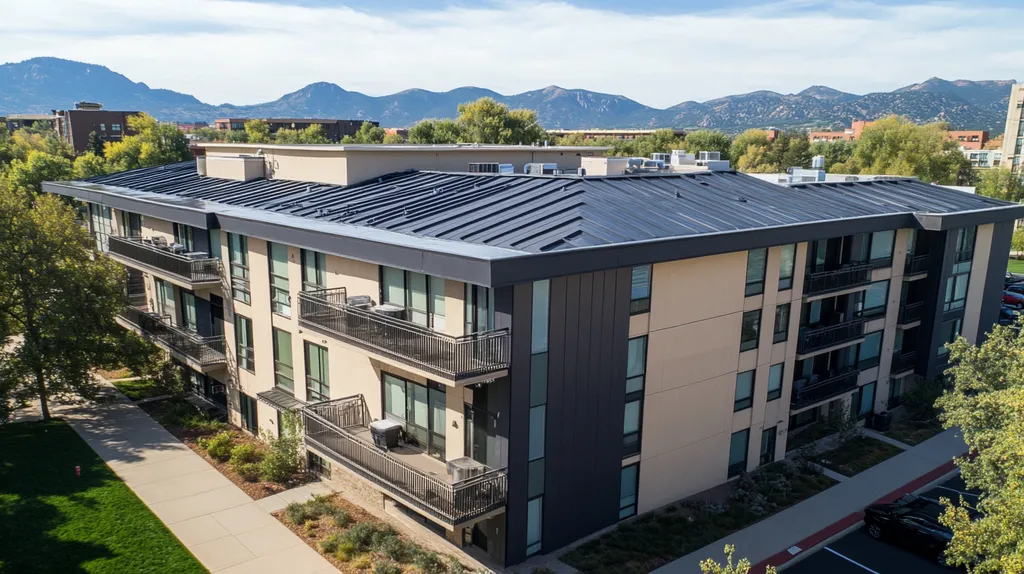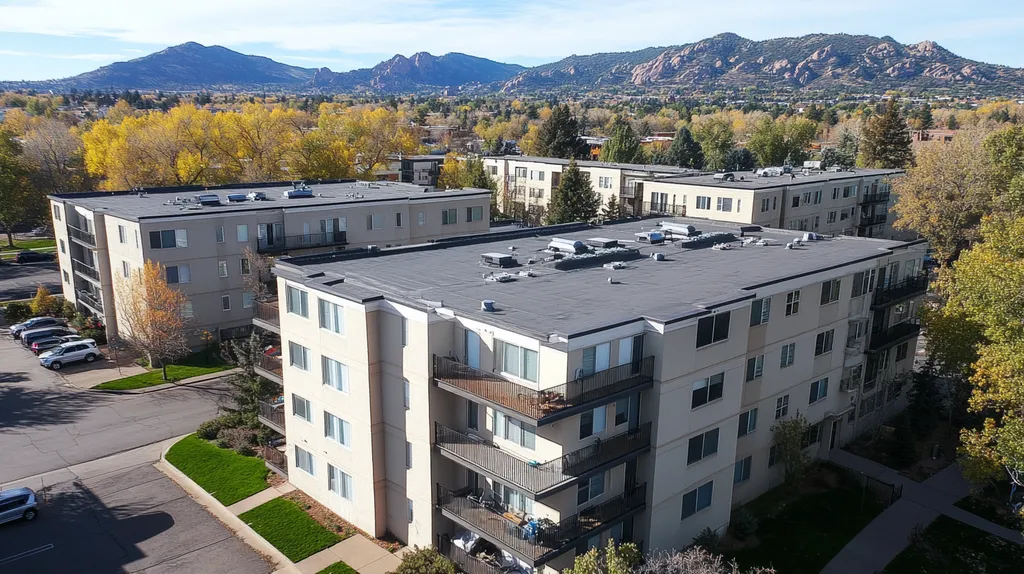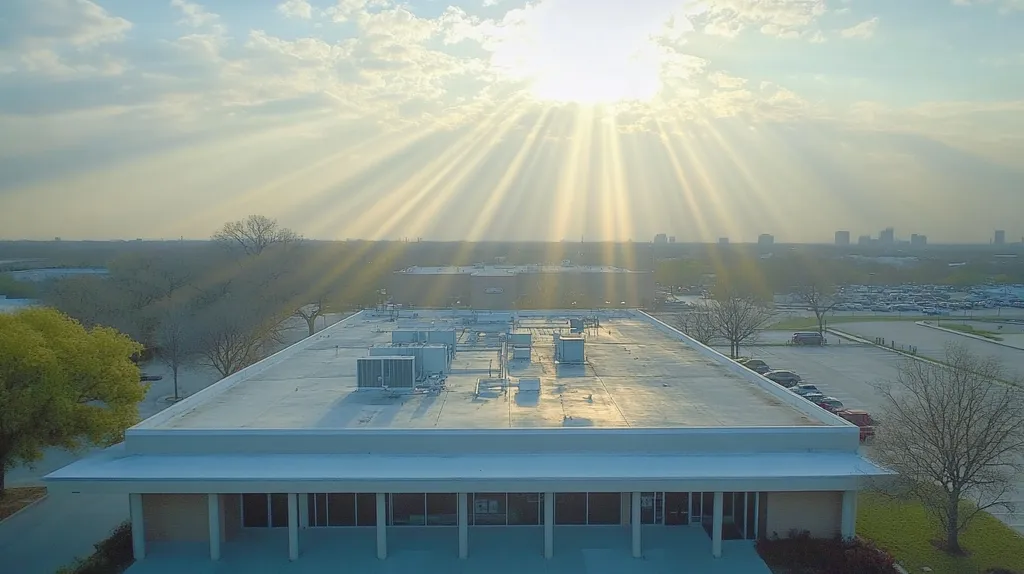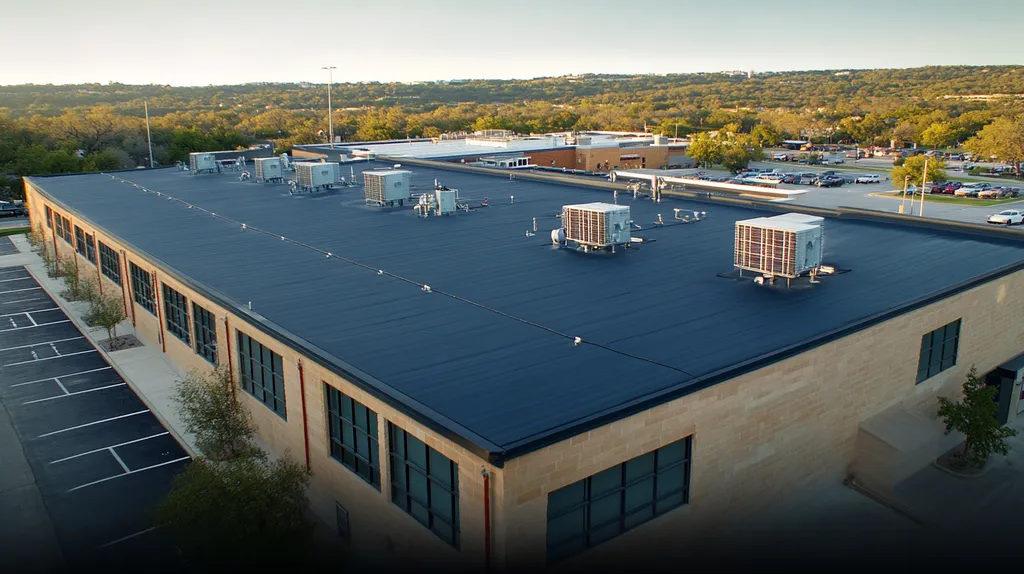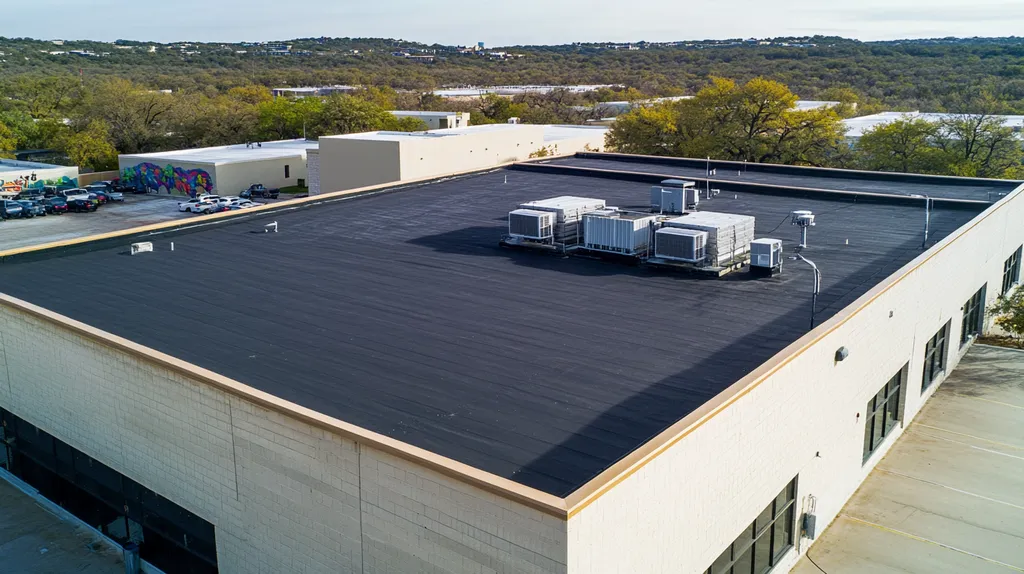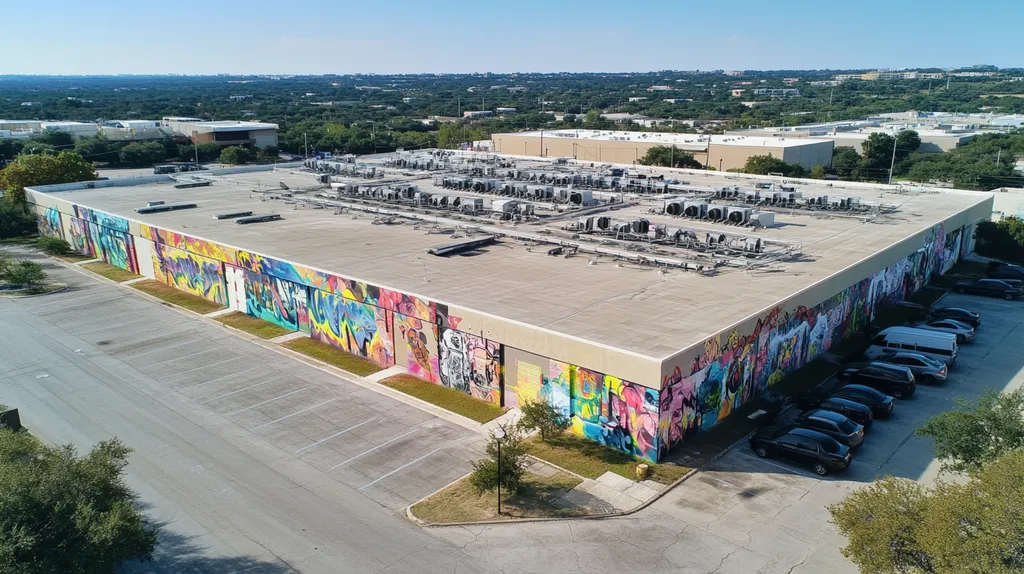Commercial roof coating failures cost property owners over $3.5 billion annually, with more than 80% of these expensive disasters traced directly to inadequate preparation. Even premium coating materials can fail within months when crucial preparation steps are overlooked or rushed.
Beyond immediate leaks and water damage, improper coating preparation leads to skyrocketing energy costs, voided warranties, and premature roof replacement. The stakes couldn’t be higher for facility managers and building owners.
This comprehensive guide breaks down the critical factors, common pitfalls, and industry-proven best practices that determine coating success or failure. Understanding these essential elements transforms coating projects from risky uncertainties into predictable, long-lasting protection.
SECTION 1: THE BASICS EXPLAINED
Commercial roof coating preparation stands as one of the most critical yet frequently overlooked aspects of building maintenance. Industry data shows that improper preparation leads to coating failures in over 80% of premature roof deterioration cases. Beyond the immediate threat of water damage, inadequate coating preparation can slash a roof’s expected lifespan by half while doubling energy costs. Understanding the fundamentals of roof coating is essential for protecting your facility’s most vital defensive asset.
What It Is (In Plain Language)
A commercial roof coating is essentially a fluid-applied shield that creates a seamless, protective membrane over your existing roof surface. Think of it as a sophisticated raincoat for your building, but one that also reflects heat and prevents UV damage.
These coatings come in several formulations, including acrylic, silicone, and polyurethane. Each type offers specific advantages, from superior waterproofing to enhanced UV resistance, allowing you to match the coating to your building’s unique challenges.
The coating system consists of multiple components: primers to ensure adhesion, the main coating layer for protection, and sometimes reinforcement materials for high-stress areas. When properly applied, these elements work together to form a cohesive defensive system.
Unlike traditional roofing materials, these coatings can be applied without disrupting building operations. They cure to form a monolithic layer that eliminates seams – the most common point of failure in conventional roofing.
Why It Matters (To Your Building)
A properly prepared and applied roof coating serves as your building’s first line of defense against environmental threats. It prevents water infiltration, reflects harmful UV rays, and maintains consistent interior temperatures.
The financial implications are significant. A well-executed coating project can extend your roof’s life by 10-15 years, potentially saving hundreds of thousands in premature replacement costs. Additionally, reflective coatings can reduce cooling costs by up to 35% during peak summer months.
Proper preparation directly impacts the coating’s adhesion and longevity. When corners are cut during preparation, even the highest quality coating materials can fail within months instead of lasting years.
Beyond protection, these systems contribute to sustainability goals. By extending roof life and reducing energy consumption, they help minimize landfill waste and lower your building’s carbon footprint.
How It Works
Successful roof coating performance depends entirely on proper preparation and application procedures. The coating must bond completely with the existing roof surface to create an effective protective barrier.
Proper roof deck preparation is essential to prevent future defects like blistering. All existing leaks and damage must be repaired before coating application begins, and the surface must be thoroughly cleaned to ensure proper adhesion. (source: Johns Manville Coatings Application Guide)
The coating creates its protective power through multiple mechanisms. It reflects UV radiation, prevents water penetration, and accommodates building movement through its elastomeric properties.
Temperature and humidity during application significantly impact performance. Most coatings require specific environmental conditions and cure times to achieve their full protective potential.
Regular inspection and maintenance of the coating system ensure it continues performing at peak effectiveness throughout its service life. Small issues can be addressed before they develop into major problems.
SECTION 2: PRACTICAL APPLICATIONS
Commercial roof coatings represent a critical investment in building protection, yet statistics show that 70% of premature coating failures stem from inadequate understanding of practical applications. Every year, facility managers face mounting repair costs and energy losses due to improper coating choices and timing. By mastering the practical aspects of roof coating systems, property owners can transform their roofs from vulnerable liabilities into high-performance assets that deliver decades of protection.
Common Uses & Examples
Modern roof coatings serve multiple critical functions across various commercial and industrial settings. From data centers requiring precise temperature control to manufacturing facilities needing superior chemical resistance, these systems deliver targeted solutions for specific facility challenges.
Metal roofs particularly benefit from specialized coating applications that prevent rust and seal seams. These coatings can extend metal roof life by 15-20 years while dramatically reducing thermal expansion stress.
Built-up and modified bitumen roofs often receive reflective coatings to combat UV degradation and reduce cooling loads. These applications can decrease roof surface temperatures by up to 80 degrees Fahrenheit during peak summer conditions.
Before application, the roof surface requires thorough cleaning and repair of any damage, while specific primers may be needed depending on the substrate and coating type. Proper surface preparation directly impacts the coating’s ability to provide long-term protection. (source: Good At Waterproofing)
When You Need It Most
The optimal timing for roof coating application aligns with key facility lifecycle points. These include when the roof reaches 75% of its expected lifespan, after major equipment installations, or before severe weather seasons.
Facilities experiencing high energy costs often benefit from immediate coating applications. A properly timed coating project can reduce cooling expenses by 25-35% during the first year alone.
Buildings showing early signs of roof aging, such as surface oxidation or minor leaks, present ideal timing for coating intervention. Early application prevents these minor issues from escalating into major structural problems.
Seasonal considerations play a crucial role in coating success. Most systems require specific temperature and humidity ranges during application to achieve optimal adhesion and curing.
Interactions With Other Systems
Roof coatings must work in harmony with existing building components to maximize effectiveness. This includes HVAC units, solar installations, and roof penetrations, which all require special attention during coating application.
Ventilation systems significantly impact coating performance. Proper air flow helps prevent moisture accumulation beneath the coating, while inadequate ventilation can lead to premature coating failure.
Lightning protection systems and satellite equipment require careful integration with coating systems. This often involves additional reinforcement and specific coating techniques around mounting points.
Building expansion joints and seismic considerations demand flexible coating solutions. The coating system must accommodate structural movement while maintaining its protective properties.
SECTION 3: KEY TERMINOLOGY DECODED
The roofing industry’s specialized vocabulary can make or break a coating project’s success. Studies show that terminology confusion leads to 35% of coating specification errors, resulting in millions in premature failures annually. When facility managers misinterpret critical terms like “dry film thickness” or “substrate preparation,” even premium coating materials can fail within months instead of protecting for years.
Essential Terms Explained
Substrate refers to your existing roof surface – whether metal, modified bitumen, or single-ply membrane. This base material determines every aspect of your coating project, from surface preparation to product selection.
Dry Film Thickness (DFT) measures the final thickness of your cured coating layer. This critical measurement, typically 15-20 mils, directly impacts the coating’s protective capabilities and longevity.
Adhesion describes how strongly the coating bonds to your roof surface. Poor adhesion leads to blistering, peeling, and coating failure – making proper surface preparation absolutely essential.
Solar Reflectance Index (SRI) indicates how effectively your coating reflects sunlight and releases absorbed heat. Higher SRI values translate to lower cooling costs and extended roof life.
Industry Jargon Translated
Elastomeric coatings flex and move with your building, maintaining protection despite thermal expansion and structural shifts. This flexibility prevents cracking and separation that rigid coatings can’t handle.
Proper roof deck preparation involves thorough cleaning, repair of existing damage, and specific surface treatments. This foundational step determines whether your coating will last 2 years or 20 years. (source: Johns Manville Coatings Application Guide)
Tensile strength measures your coating’s ability to resist tearing under stress. Higher tensile strength means better durability against foot traffic, debris impact, and severe weather.
Permeability rates show how readily water vapor passes through your coating. The right permeability balance prevents moisture trapping while maintaining waterproof protection.
Measurement & Units Simplified
Coverage rates tell you how many square feet one gallon of coating will protect. Most coatings cover 80-100 square feet per gallon when applied at recommended thickness.
Mil thickness equals one-thousandth of an inch. A 20-mil coating may seem thin, but this engineered thickness provides optimal protection while avoiding material waste.
Ambient temperature requirements specify the correct conditions for coating application. Most systems need temperatures between 50-90°F and humidity below 85% for proper curing.
Elongation percentage shows how far your coating can stretch without breaking. A 200% elongation rating means the coating can stretch to three times its original size while maintaining integrity.
SECTION 4: DECISION FACTORS
Commercial roof coating decisions directly impact building performance and operational costs for decades. Industry data reveals that over 65% of premature coating failures stem from misaligned decision-making in the selection process, resulting in billions in unnecessary repairs and replacements annually. Understanding the complex interplay between cost, performance, and longevity empowers facility managers to make choices that maximize protection while optimizing their investment.
Cost Considerations
Initial coating costs typically range from $0.50 to $4.00 per square foot, but focusing solely on these numbers overlooks crucial long-term financial implications. Premium coatings often deliver three times the service life of budget alternatives while reducing maintenance expenses by up to 60%.
Energy savings potential should factor heavily into cost calculations. High-performance reflective coatings can reduce cooling costs by 25-35% annually, often paying for their premium price within the first three years of service.
Labor costs for application and eventual recoating represent 40-60% of total project expenses. Selecting a longer-lasting coating system significantly reduces these recurring costs over the building’s lifecycle.
Warranty coverage varies dramatically between coating systems, affecting long-term risk exposure. Premium coatings typically offer 15-20 year warranties, while budget options may provide only 5-7 years of coverage.
Performance Trade-offs
Different coating formulations excel in specific performance areas while potentially sacrificing others. Silicone coatings offer superior waterproofing and UV resistance but may have reduced durability against foot traffic compared to polyurethane systems.
Climate considerations dramatically impact coating performance. Hot, sunny regions benefit most from high-reflectivity coatings, while areas with frequent rainfall require superior waterproofing characteristics.
Chemical resistance becomes crucial near industrial exhaust systems or in areas with high pollution levels. Some coatings offer excellent chemical protection but may cost 30-40% more than standard formulations.
Application temperature ranges vary significantly between coating types. While some can be applied in near-freezing conditions, others require temperatures above 50°F, potentially limiting installation windows.
Lifespan & Durability Factors
Expected service life varies dramatically based on environmental exposure and maintenance practices. Regular inspection and maintenance can extend coating life by 25-40% compared to “install and forget” approaches.
Surface preparation quality directly correlates with coating longevity. Proper cleaning and preparation can double the effective lifespan of any coating system, while rushed preparation virtually guarantees premature failure.
Thickness and number of coating layers significantly impact durability. Single-coat systems may reduce initial costs but typically provide only half the protection of properly applied multi-coat systems.
UV exposure, ponding water, and mechanical damage from foot traffic represent the primary threats to coating longevity. Strategic choices in coating type and thickness can effectively counter these specific degradation mechanisms.
SECTION 5: COMMON CHALLENGES
Despite advances in coating technology, industry statistics reveal that 75% of commercial roof coating failures stem from preventable challenges during preparation and application. These failures cost facility owners over $2.5 billion annually in premature replacements and repairs. Even more concerning, improper coating installation can void manufacturer warranties and create liability issues when water damage affects building contents and operations.
Frequent Problems & Solutions
Adhesion failure ranks as the most common and costly coating issue, affecting up to 40% of commercial installations. This typically results from inadequate surface cleaning, improper primer selection, or application during unsuitable weather conditions.
Moisture entrapment beneath coatings creates blistering and delamination that can compromise entire roof sections. Advanced moisture detection equipment and proper drying procedures can prevent these costly failures.
Inconsistent coating thickness leads to premature wear and system breakdown. Installing thickness gauges during application ensures uniform coverage that meets manufacturer specifications.
Proper roof deck preparation is essential to prevent coating defects like blistering and surface contamination. All existing leaks and damage must be repaired before coating application begins, with special attention paid to minimizing exposure of fresh asphaltic materials. (source: Johns Manville Coatings Application Guide)
Warning Signs To Watch For
Surface crazing and micro-cracking often appear 3-6 months before major coating failure. These early warning signs indicate stress points where the coating system is beginning to break down.
Discoloration patterns and chalking reveal areas of accelerated degradation. Regular inspection can identify these issues before they compromise the coating’s protective properties.
Ponding water that remains for more than 48 hours signals drainage problems that will stress any coating system. Addressing drainage early prevents coating breakdown and substrate damage.
Separation at seams and penetrations indicates potential system failure points. These areas require immediate attention to prevent water infiltration into the building.
Preventative Approaches
Environmental monitoring during application dramatically improves coating performance. Temperature, humidity, and dew point must all fall within manufacturer specifications for optimal results.
Implementing detailed pre-coating inspection protocols catches 90% of potential failure points before they impact installation. This includes core sampling, adhesion testing, and moisture scanning.
Regular maintenance programs extend coating life by up to 60%. Scheduled cleaning, inspection, and minor repairs prevent small issues from escalating into system failures.
Documentation of all coating work, including surface preparation methods and environmental conditions, provides crucial warranty protection. This record-keeping proves proper installation procedures were followed.
SECTION 6: NEXT STEPS & RESOURCES
The path from coating selection to successful implementation demands rigorous attention to detail and expert guidance. Industry data reveals that 65% of commercial property owners lack critical information when making coating decisions, leading to $3.2 billion in premature failures annually. Without proper knowledge and resources, even premium coating materials can fail within months instead of protecting for decades. Understanding where to turn for reliable information and which questions to ask transforms uncertain coating projects into predictable successes.
Questions To Ask Providers
Start by investigating the contractor’s specific experience with your roof type and chosen coating system. Request detailed documentation of completed projects matching your scope, including performance data and client references spanning at least five years.
Demand clarity on surface preparation protocols, including moisture testing methods, cleaning procedures, and repair strategies. The most qualified contractors will outline their quality control measures and inspection points throughout the project timeline.
Scrutinize material specifications and application procedures carefully. Professional contractors should provide detailed documentation of their coating system selection process, including environmental compatibility analysis and substrate testing protocols.
Verify warranty terms and maintenance requirements before proceeding. Top contractors offer comprehensive coverage that includes both materials and labor, backed by manufacturer partnerships and documented maintenance programs.
Industry Standards & Guidelines
Proper roof deck preparation stands as the cornerstone of coating success. All existing leaks and damage must be repaired before coating application begins, with special attention paid to minimizing exposure of fresh asphaltic materials. (source: Johns Manville Coatings Application Guide)
Quality standards from organizations like ASTM International provide crucial benchmarks for coating performance. These include minimum requirements for adhesion strength, weathering resistance, and elongation properties that determine long-term durability.
Building codes and energy requirements vary by region but typically specify minimum reflectivity values and installation procedures. Understanding these requirements prevents compliance issues that could void warranties or trigger costly corrections.
Safety protocols from OSHA and industry associations outline essential requirements for worker protection and fall prevention. These standards must be integrated into project planning from the earliest stages.
Further Learning Simplified
Leading coating manufacturers offer comprehensive online training programs and technical resources. These platforms provide detailed insights into product selection, application techniques, and troubleshooting procedures without overwhelming technical jargon.
Professional organizations like NRCA and RCMA maintain extensive libraries of case studies and best practices. Their educational materials translate complex coating science into practical guidelines for property owners and facility managers.
Regional roofing associations frequently host seminars and workshops focused on local climate challenges and solutions. These events provide valuable networking opportunities while delivering targeted information relevant to your specific situation.
Digital platforms now offer virtual roof assessments and coating consultations with industry experts. These services can provide preliminary guidance and help identify potential challenges before significant investments are made.
The Bottom Line
With over $3.5 billion lost annually to coating failures, proper preparation stands as the defining factor between long-term protection and expensive disaster.
The evidence is clear: 80% of premature coating failures trace directly to inadequate surface preparation and rushed application processes.
Success demands rigorous attention to surface cleaning, moisture testing, and environmental monitoring during installation – there are no shortcuts to lasting protection.
By following industry-proven preparation protocols, facility managers transform their roofs from vulnerable liabilities into high-performance assets that deliver decades of reliable service.
The choice is stark: invest in proper preparation now or pay exponentially more for premature failure and replacement later.
FREQUENTLY ASKED QUESTIONS
Q. What is commercial roof coating preparation?
A. Commercial roof coating preparation involves cleaning, repairing, and priming the existing roof surface. This critical step ensures that the coating adheres properly and lasts longer. Failing to prepare can lead to coating failures and costly repairs, significantly reducing the roof’s lifespan.
Q. What practical applications exist for a commercial roof?
A. Commercial roof coatings are utilized to enhance waterproofing, UV protection, and energy efficiency. They are especially beneficial for metal roofs needing rust protection and modifications for thermal stress. Understanding these practical applications ensures effective solutions tailored to each facility’s unique challenges.
Q. What are essential terms related to commercial roofs?
A. Key terms include substrate, dry film thickness, and adhesion. Understanding these concepts is crucial for successful coating applications. Each term impacts coating effectiveness and can prevent costly failures when properly applied and monitored during installation.
Q. How do I choose the right commercial roof coating?
A. Selecting the correct coating requires understanding both cost and performance trade-offs. Consider long-term durability and energy savings, as these factors can significantly impact total expenses. Look for coatings that align with your specific environmental conditions and building needs for optimal performance.
Q. What common challenges affect industrial roof coatings?
A. Challenges include adhesion failures and moisture entrapment, which can cause blistering. Proper surface preparation and environmental monitoring are essential during application to prevent these issues. Addressing these challenges proactively protects your investment and ensures the coating’s longevity.
Q. How can I prepare for a successful commercial roof coating project?
A. Start by conducting a thorough roof inspection and cleaning. Identify and repair any damage, ensuring a smooth surface. Additionally, consult with qualified professionals to choose the right coating system while verifying that your project meets all necessary standards and guidelines.
Q. Where can I find more resources about commercial roofs?
A. Look for training programs offered by coating manufacturers and engage with professional organizations. Websites of industry leaders provide detailed insights, while local roofing associations host relevant workshops and seminars to enhance your knowledge about roof coating technologies.

